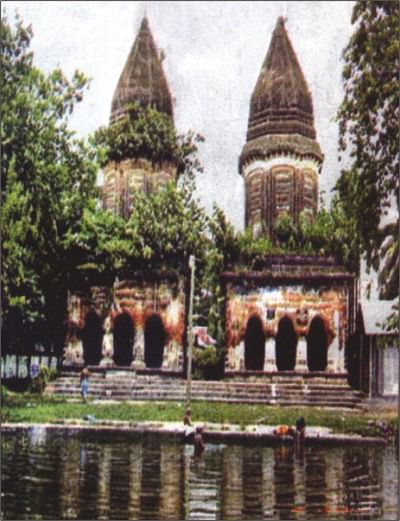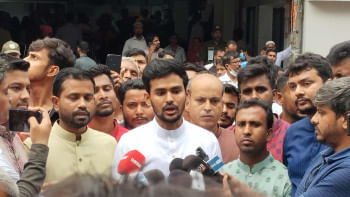Falling to pieces: The twin temple of Muktagachha

The twin temple in Muktaghachha.
A twin temple -- Shree Shree Anandamoyi Shiva and Kali Mata Mandir -- that dates back around 200 years, is located in Muktagachha upazila headquarters. Unfortunately, the temple is in a dilapidated condition due to the utter negligence of the concerned authority. The Archaeological Department had declared this temple as an archaeological site over 15 years ago to prevent it from further decay, but the only sign of supervision that remains are the signboards.
The temple was built just outside the palaces of Muktagachha Zamindars. The temple is unique in its design. It is oblong in shape with little corridors on a high basement. The basement is connected with a staircase that leads to a pond.
Intrigued by its history, visitors from home and abroad have stopped by at the temple on various occasions. Veena Sikri, former Indian High Commissioner to Bangladesh, visited some old temples in the area, including the twin temple, in 2006.
The temple was built in 1820 by Bimola Devi, mother of Maharaja Shashikanta Acharya Chowdhury, an accomplished zamindar of Muktagachha. A large pond was dug in the front for easy supply of water for the devotees who thronged the temple on different occasions.
The temple, also known as 'Dakshineshwar Temple,' is the second of its kind in Asia with another such temple in Kolkata. Religious functions including Durga Puja, the solemnisation of marriage, religious rituals, sacrificial activities (especially on the occasion of Kali and Manasha Puja), Annaprashan etc are held on the temple premises and the custom has come down the ages.
The Rabidas community, a scheduled caste of the Hindus, perform their two-day long Kattyani Puja, locally known as the 'Shat' Puja, centring the pond on the temple premises in the Bengali month of Kartik.
Special puja are held on every full moon and new moon and on the occasion of Pahela Baishakh. Devotees from far and wide gather at the temple on various occasions to seek blessings from the deities. The other distinguishing feature of the temple is that only the purohit (priest) can enter the main room of the temple where the idols are placed.
According to sources, through local initiatives some construction work on the temple, including its boundary walls, was carried out at a cost of Tk 98,000 -- collected from local devotees -- a few years ago. However, they say, this amount is insufficient to restore the temple from decay.
Rakesh Chakraborty, the present purohit of the temple, said that they were unable to perform their customary worship marking the new moon on September 18 as rainwater trickled in through the many cracks that had developed in the temple. This made it even more difficult for the devotees to stay in the precincts of the temple. To observe the Durga Puja, devotees in their hundreds rush to the temple every year, the purohit added.
Steps for renovation work to protect the temple from final ruination should be taken quickly as it is an asset with a rich cultural heritage, said a source in the local Archaeological Department.

 For all latest news, follow The Daily Star's Google News channel.
For all latest news, follow The Daily Star's Google News channel. 



Comments